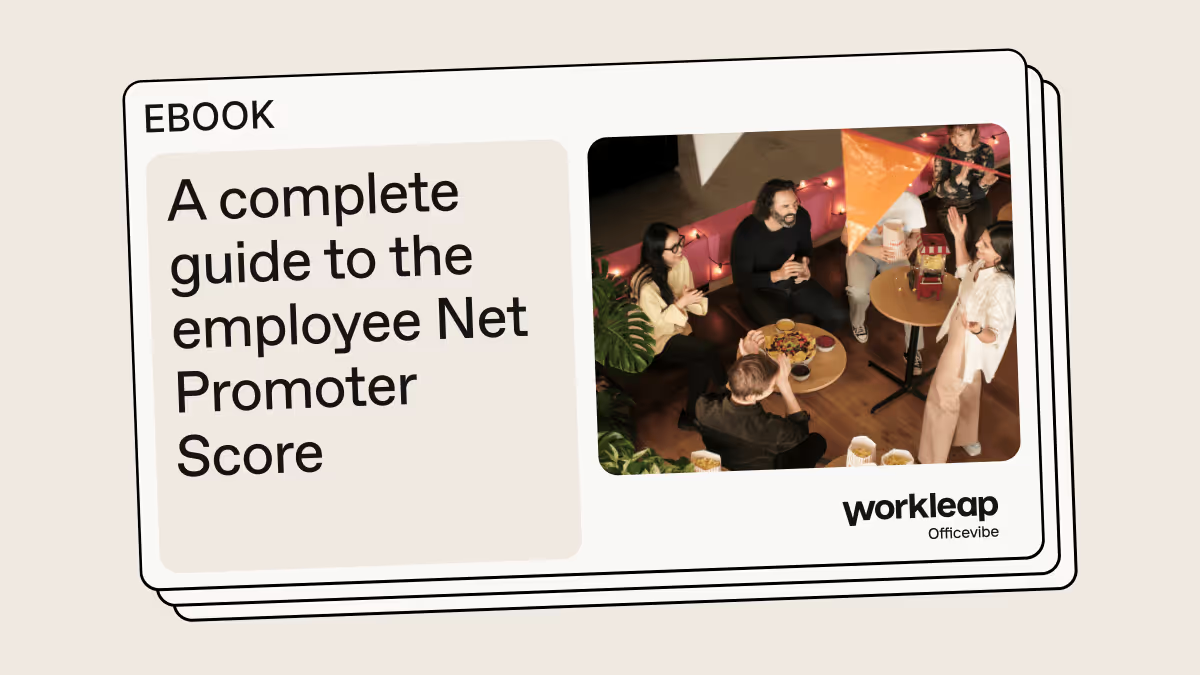8 Key metrics to measure your employee experience

Discover Workleap Officevibe's benchmark report on 12 key employee engagement metrics

Are you a performance-driven manager? If so, you likely ask yourself the following questions regularly:
- How can I improve productivity in my team?
- How can my department be more innovative?
- How can we better contribute to our organization's goals and objectives?
Finding the solution to these challenges begins with the people working in your organization. And the best way to reach optimal performance in your team is by measuring employee experience KPIs and acting on your findings in a constructive, timely fashion.
In this article, we'll give you the 411 on how to measure your employee experience (EX) so you can establish a positive workplace culture and productive work environment.
What is employee experience?
Employee experience is how team members observe, interpret, and internalize all the interactions with an organization. It involves all organizational encounters, or touchpoints, throughout the employee lifecycle, including:
- The interview process
- Onboarding after a new hire
- The training process
- Internal promotions
- Pulse surveys
- Exit interviews
Traditionally, employee experience factors are broken down into three categories:
- Physical workspace: These factors include a safe and practical work environment and a convenient office location. Perks, such as lunch stipends and career counseling, are also physical workplace factors.
- Cultural: The organizational structure should give employees the opportunity for future growth. Cultural employee experience factors also include fair compensation with sufficient retirement and healthcare benefits.
- Technological: Employees should have sufficient resources to do their jobs. For example, high-performing computers and speedy networks can improve employee engagement and experience. On the other hand, outdated systems can contribute to poor employee experience.
In the era of distributed work, other factors that can enhance employee experiences include:
- Flexibility and good work-life balance
- Transparent and open communication
- Organizational trust
- Meaningful input
- Healthy co-worker and manager relationships
- Voice, empowerment, and accountability (VEA)
{emphasize}Recognition and feedback are also crucial to promoting employee engagement. According to Officevibe’s Pulse Survey data, 83% of employees appreciate receiving feedback, whether positive or negative.{emphasize}
The importance of a positive employee experience
Why should an organization aim to improve its employee experience?
When employees feel good about going to work, organizations tend to see a sustainable increase in business success. A few things contribute to this increase in business performance:
- Optimal employee retention: Maximizing employee experience boosts retention rates because happier, more engaged employees feel less of an urge to leave their organizations in search of something new. Employees that stick around become experts and ambassadors at your organization, ultimately contributing to long-term company success.
If that's not reason enough, high turnover can be really expensive. According to Gallup, replacing existing employees can cost up to two times the employee’s salary.
{emphasize}Many business leaders underestimate the financial significance of happy, engaged employees. We've gathered compelling insights on the Return on Investment (ROI) from employee experience to help reframe this essential perspective{emphasize}
- Improved engagement: High employee engagement brings a slew of benefits. For starters, an engaged employee is likelier to be more productive and go the extra mile for their organization. Not only do these employees drive up their own performance, but they often pull the rest of the team with them.
It's clear then that engagement is super important and should be prioritized. However, promoting engagement can be challenging if your organization doesn’t focus on the broader employee experience. One cannot live without the other. - Easier recruitment: Promoting employee experience should be the bedrock of your employee recruitment strategy. Top talent is in high demand these days. If a talented candidate knows that your organization is serious about building a positive company culture and providing growth opportunities, they'll be more likely to apply for a vacant position. And if you can highlight your EX throughout the interview process, winning them over will be a breeze.
💡Pro tip: Including other employees and brand ambassadors throughout your interview process is a great way to show your employee experience at work. Candidates will see others living and breathing your EX, and it can make all the difference in their decision-making. - Improved customer experience: Energized employees with a positive experience at work are also more likely to transpire this positivity externally, engage with customers, and provide them with high-value solutions. This is sure to improve your customer advocacy loop and will keep clients engaged with your products and services.
{emphasize}The past two years have changed the reality of work forever. Read our latest data report for insights about the current state of employee experience and how leaders and companies can shape it in the future.{emphasize}
[ov_cta id="5121631"]
8 KPIs to measure employee experience
Key performance indicators (KPIs) are metrics that measure employee experience levels within your organization. These quantitative and qualitative data points eliminate guesswork when you need to determine the quality and effectiveness of employee interactions.
Instead of asking your team questions on the fly, you can strategically create employee surveys based on these indicators to get valuable insight into specific employee experience factors. The results will not only show you where your EX is excelling but also help you identify problem areas that need attention.
If you're not sure where to start, we've got you covered with eight employee experience metrics you can track to keep your EX thriving.
1. Satisfaction levels
This employee experience KPI provides qualitative data on how team members generally feel at work. More specifically, the employee satisfaction metric gauges your team members' satisfaction levels around their role in the organization, compensation, and the workplace as a whole.
Measuring employee satisfaction starts with asking the right questions; otherwise, you'll find it challenging to quantify. Here are a few you can ask:
- Do you feel you are making a difference in the organization?
- Are you satisfied with the resources at your disposal?
- On a scale of 0 to 10, how satisfied are you with your compensation and benefits package?
- Are you comfortable in your work environment?
Once you have your team's responses, you'll be primed to act on the right pain points. You'll quickly find low-hanging fruit that will make all the difference in your employee experience.
{emphasize}
Employee experience surveys and one-on-one conversations offer great avenues to gain an in-depth understanding of satisfaction levels within a department or company.{emphasize}
2. Employee Net Promoter Score (eNPS)
The employee Net Promoter Scores is a critical metric to measure when evaluating employee experience, and would typically be included in a survey annually.
The eNPS is a key performance indicator that asks employees: “Using a scale from 0 (unlikely) to 10 (highly likely), what is the likelihood that you would recommend your current place of employment as a good place to work?”
Depending on their answers, employees will fall into one of three categories:
- Promoters: A score of 9 or 10
- Neutrals: A score of 7 or 8
- Detractors: A score of 0 to 6
{emphasize}
To calculate your eNPS, subtract the number of detractors from the number of promoters, then divide the answer by the number of respondents.{emphasize}
An eNPS of 30 or higher might indicate relatively high levels of employee satisfaction. The number of neutrals doesn’t impact this score, as these employees are generally indifferent towards the organization as an employer.
{emphasize}💡Pro-tip: While neutrals aren't considered in the eNPS formula, they should not be ignored as they likely represent the largest part of your workforce. You'll want to identify who your neutrals are and implement practical improvements based on their survey feedback to transform them into promoters.{emphasize}
3. Internal referrals
A metric that often gets overlooked when measuring employee experience is the number of referrals your team members are sending HR's way. While it's closely linked with the employee Net Promoter Score, this KPI shows ambassadorship in practice, not just theory.
Think about the times you've referred people you know for a job at your organization – and the times you didn't. More likely than not, employees refer others only when they feel positively about their employee experience. If you don't enjoy the environment you work in, you probably wouldn't want to share that burden with someone else. On the other hand, if you feel engaged day-in-day-out, you'll be happy to see others experience that as well.
Aside from giving you a snippet of where your EX stands, referrals and a good referral program can also do wonders when it comes to actually shaping your employee experience. LinkedIn data shows that people who refer others, especially those who refer others successfully, stay longer at their organizations.
4. Employee productivity
According to a study by the Saïd Business School of Oxford University, employees who are happy at work are, on average, 13% more productive than their counterparts. So, measuring productivity levels will give you a pretty good idea of how your EX is perceived by employees.
A great way to measure your team's productivity is by setting actionable goals on a quarterly or yearly basis and following up on your team's progress regularly. If goals are consistently reached or even surpassed in a department, it's a sign of a positive and motivating employee experience. Once you've gauged productivity levels, you'll be able to improve them over time to help your team do their best work, always.
5. Retention rates
Your employee retention KPI is a big reflection of your employee experience. It's a no-brainer. People stay where they feel happy, motivated, and inspired on the daily.
{emphasize}Employee retention = (number of employees at the end of the year ÷ number of employees at the beginning of the year) x 100{emphasize}
For example, suppose 150 staff members worked for the organization at the start of January, and this number increased to 170 by the end of December. In this case, 20 employees started a new job at the company, and your retention rate is 113%.
A positive retention rate of over 100% indicates high employee experience levels. If retention rates improve over time, it also means that the steps you take to enhance employee experience are effective.
{emphasize}Looking to improve retention? Asking employees what they need during regular touchpoints is a great way to make them feel heard. By opening lines of communication, you're paving the way for healthy relationships, higher retention, and ultimately a better employee experience.{emphasize}
6. Employee absenteeism
Keeping absenteeism rates as low as possible is critical to not only maximizing profitability but also employee engagement. Absenteeism can significantly affect productivity and cost your organization thousands of dollars over a year. When an employee is absent for non-urgent issues, it also increases the workload on other employees, which affects their performance and can create a vicious cycle.
{emphasize}Absenteeism rate = (number of absences ÷ total number of workdays in a year) x 100{emphasize}
Generally, a low absenteeism rate (the closer to zero, the better) indicates a positive employee experience. Employees who are optimistic about their work environment are less likely to play hooky or use minor excuses not to come in.
7. Recognition frequency
Relationships and human interactions are often the backbone of a company's culture. So, if you want to measure the employee experience, you'll want to take a look at how these relationships pan out at work.
The recognition KPI can give managers and leaders great insights, especially when it's given among peers. Colleagues who take the time to recognize each other, whether to acknowledge someone's hard work or simply thank them for being awesome, contribute to a better EX for all.
A great recognition frequency varies per organization, so we recommend tracking your own metric over time to identify trends within your company. Once you have an idea of what the status quo is, you can work to improve or maintain your recognition levels.
8. Wellness
When employees increasingly encounter physical or mental health issues, especially deriving from work-related issues, it can drastically impact their employee experience. Factors that can take a toll on employee wellness include:
- Unrealistic workloads and expectations
- Insufficient health and safety policies
- Poor management and communication practices
- Inflexible work hours
- A workplace culture of harassment or bullying
- An environment that does not value diversity and inclusion
Gathering quantitative data on employees’ wellness can be challenging. However, you can determine how your team is feeling and what factors are taking a toll on their wellbeing by sending employee wellness surveys regularly. You can also pay close attention to other metrics, like your absenteeism rate, as both metrics often move in the same direction.
{emphasize}😌 Prioritize conversations around mental health and use these stress and wellbeing templates for upcoming surveys and one-on-ones.{emphasize}
Employee engagement surveys: A simple tool to measure employee engagement and experience
Gone are the days where decision-making around employee experience happens haphazardly. Keeping a pulse on your EX requires care and attention, so measuring employee experience should come as a long-term strategy. Having a dedicated employee experience survey set in place will help you:
- measure how your team is feeling in real-time
- identify specific areas of improvement
- track trends and fluctuations overtime
- see where you're already doing great
Make your employee experience shine with Officevibe
Having a great employee experience makes perfect business sense. The happier and more engaged your team is, the better the business performs as a whole.
Officevibe's Pulse Survey tool provides a no-fuss, effective solution so you can start measuring employee engagement and gaining insights into your team's experience in no time. Before you know it, your EX will be on the rise and there will be no looking back.
{emphasize}Curious about how our surveys work? Kick off your employee experience improvement journey with an Officevibe demo.{emphasize}
Give HR and managers the clarity, confidence, and connection to lead better every day.


%20(1).avif)


.avif)
.avif)







